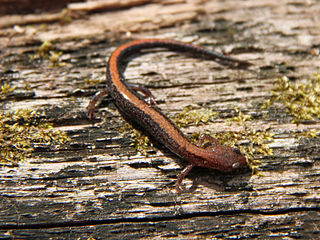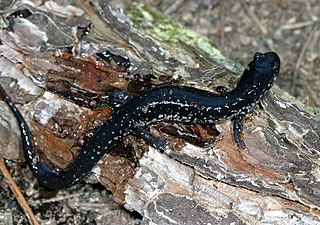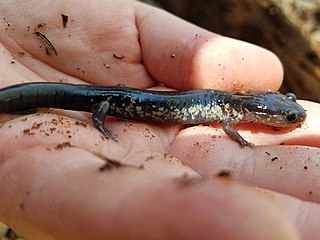
Plethodon is a genus of salamanders in the family Plethodontidae. They are also known as woodland salamanders or, more rarely, slimy salamanders. All members of the genus are endemic to North America. They have no aquatic larval stage. In some species, such as Plethodon cinereus, the red-backed salamander, eggs are laid underneath a stone or log. Young hatch in the adult form. Members of Plethodon primarily eat small invertebrates. The earliest known fossils of this genus are from the Hemphillian of Tennessee in the United States.

Wehrle's salamander is a species of salamander in the family Plethodontidae. It is endemic to the Eastern United States. It is named in honor of Richard White Wehrle (1852–1937), a jeweler, naturalist, and collector of the holotype.

The northern slimy salamander is a species of terrestrial plethodontid salamander found throughout much of the eastern two-thirds of the United States.

The southern red-backed salamander is a species of salamander endemic to the United States. It is found in four widely disjunct populations: one in central Louisiana; one in the Ouachita Mountains of Arkansas and Oklahoma; one in central Missouri; and one from southeastern Tennessee, to southwestern North Carolina, western Georgia, and eastern Alabama. It is sometimes referred to as the Georgia red-backed salamander or the Ouachita red-backed salamander. It was once considered a subspecies of the red-backed salamander, Plethodon cinereus.

The Cheat Mountain salamander is a species of small woodland salamander found only on Cheat Mountain, and a few nearby mountains, in the eastern highlands of West Virginia. It and the West Virginia spring salamander are the only vertebrate species with geographic ranges restricted to that state.

The Cheoah Bald salamander is a species of salamander in the family Plethodontidae endemic to the state of North Carolina in the United States. Its natural habitat is temperate forests and it is threatened by habitat loss. It was formerly considered a variant of the red-cheeked salamander until it was found to be a distinct species.

The white-spotted slimy salamander is a species of salamander in the family Plethodontidae endemic to the Eastern United States. It is one of 55 species in the genus Plethodon, and was one of the first to be described of its cogeners.

The red-cheeked salamander, also known as the Jordan's salamander, Jordan's redcheek salamander, or Appalachian woodland salamander, is a species of salamander in the family Plethodontidae. It is endemic to the Appalachian Mountains in the eastern United States.
The South Mountain gray-cheeked salamander is a species of salamander in the family Plethodontidae, endemic to the state of North Carolina in the United States, where it is only found in the South Mountains. It was formerly considered a variant of the red-cheeked salamander. Its natural habitat is temperate forests. It is threatened by habitat loss.

The northern gray-cheeked salamander is a species of salamander in the family Plethodontidae and endemic to the Blue Ridge Mountains and Appalachian Mountains in the eastern United States. It is closely related to the Red-cheeked salamander and the Red-legged salamander. Its natural habitat is temperate forests. It is found under moss, rocks, logs, and bark in cool, moist forests above 2500 feet. Especially found in spruce-fir forests. The Gray-cheeked Salamander commonly eats millipedes, earthworms, crane flies, spiders, and centipedes and less commonly eats ants, mites, and springtails. They eat spiders, moths, flies, beetles, bees, and snails. The male and female perform a courtship, where the male nudges the female with his snout, does a foot dance, then circles under the female and the two then walk together. Like other salamanders, they do not migrate or aggregate during breeding season. It is threatened by habitat loss.
The Sequoyah slimy salamander is a species of salamander in the family Plethodontidae.

The Webster's salamander is a species of salamander in the family Plethodontidae. It is endemic to the southeast United States, in patchy and disjunct lowland subpopulations ranging from South Carolina to Louisiana. Its natural habitat is mixed mesophytic temperate forests, in association with rocky streams and outcrops.

Weller's salamander is a species of salamander in the family Plethodontidae. This species in endemic to the southeastern mountain range of the United States. It is mainly found in North Carolina near Grandfather Mountain. The salamanders have a unique metallic spotting which distinguishes them from other Plethodon species and other salamanders in the area. They mainly inhabit cool forests with rocky areas.

The Chattahoochee slimy salamander (Plethodon chattahoochee) is a species of salamander in the family Plethodontidae. It is endemic to the Appalachian Mountains in the United States, where it is found only in the Chattahoochee National Forest and Nantahala National Forest in the states of Georgia and North Carolina. Its natural habitat is temperate forests. It was once classified within the northern slimy salamander (P. glutinosus) until it was found to be a distinct species. Its range narrowly intersects with the northern slimy salamander, the Atlantic Coast slimy salamander (P. chlorobryonis), and the southern Appalachian salamander (P. teyahalee) and widely intersects with the red-legged salamander (P. shermani), and it is known to hybridize with the latter three.

The Atlantic Coast slimy salamander is a species of salamander in the family Plethodontidae. It is endemic to the United States, where it is distributed throughout the Southeastern United States from southeastern Virginia to northern Georgia. It is largely distributed along the Atlantic coastal plain, although it enters the Piedmont in Virginia and South Carolina and enters the Blue Ridge Mountains in Georgia. Its habitat is largely restricted to bottomland hardwood forest. While its conservation status is considered Secure by NatureServe, declines have been noted in all studied populations.

The southeastern slimy salamander is a species of salamander in the family Plethodontidae. It is endemic to the United States, where it is distributed in the Southeastern United States from southern Georgia west to Alabama and south to central Florida. Its natural habitats are steephead valleys, maritime forests and bottomland hardwood forests.
The Savannah slimy salamander is a species of salamander in the family Plethodontidae. It is endemic to the state of Georgia in the United States, where it is restricted to the Atlantic coastal plain in Burke, Jefferson, and Richmond counties. This distribution reaches its eastern limit at the Savannah River. Its natural habitat is bottomland hardwood forest. Population analysis indicates a precipitous decline in the population of this species, and it is becoming extirpated in many areas due to development; for example, the habitat at the type locality of this species was partially destroyed by a housing development.
The Blacksburg salamander is a species of salamander in the family Plethodontidae. It is endemic to the Southeastern United States, where it is restricted to the Appalachian Mountains in southwestern Virginia and northwestern North Carolina. It is named after the town of Blacksburg, Virginia, as its first recorded sighting was within its vicinity. Its natural habitat is temperate forest.
The yellow-spotted woodland salamander is a species of salamander in the family Plethodontidae. It is endemic to the United States, where it is distributed throughout the Cumberland Plateau in the states of Kentucky and Tennessee. Its natural habitat is temperate forest. It was long considered to be both an isolated western population and a unique yellow-spotted color morph of the Wehrle's salamander, but a study published in 2019 found it to be a distinct species.














